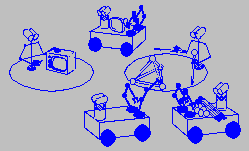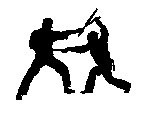




Anthony experienced contrast with both Don and Vlad. A significant value of 50% of contrast was experienced in comparison with Don's constructs. A less significant 10% was evident in comparison with Vlad. Anthony experienced no contrast with Rob and high levels (50%) of correspondence. Anthony had around 20% correspondence with Vlad and none with Don. This indicates that Anthony has a higher level of correspondence with Rob than either Don or Vlad. Don and Anthony have significantly high levels of contrast. This indicates that Don and Anthony have an amount of disjoint constructs.
Anthony had element consensus only in Rob's psychological space at 22% but had 22% element conflict as well. In Don's and Vlad's, he had high levels of element conflict at 89 & 53% respectively.
The most significant result is 100% construct conflict with Don. Anthony also got 70% construct conflict with Vlad and no consensus. The only consensus received by Anthony was 20% with Rob.

Don experienced contrast with all the other experts. He has levels of 37 & 33% contrast with Rob and Vlad respectively. He has a significant amount of contrast in comparison with Anthony at 50%. His comparisons produced 50% correspondence (with Vlad and Rob) and a low of 0% (with Anthony). When Rob and Vlad compared with Don they both had 27 & 33% correspondence respectively. The large difference between Don and the other two comparison can be explained by the fact that the other two had more constructs, especially in the case of Rob who had 11 compared to Don's eight. Another factor that may be affecting the results is that Don had to redo his grid because his first grid was lost.
Don has 22 & 11% element consensus with Vlad and Rob Respectively but none with Anthony. He has significant levels of element conflict with all the other experts. 89% element conflict with Anthony, 58% with Vlad and 44% with Rob.
Don only had construct consensus in Rob's space at 38%. He experienced significant amounts of construct conflict with Anthony and Vlad, 89 & 75%.

Rob had between 45% levels of correspondence with both Vlad and Anthony. He was able to make 27% correspondence in his comparison to Don's constructs and Don was able to make 50% correspondence in comparison to Rob. Rob's greater number of constructs; 11 versus Don's 8 accounts for the 22% difference. The only person Rob had contrast with was Don at 37%.
Rob had no element consensus with Don and 78% conflict. He had 11 $ 22% element consensus with Anthony and Vlad respectively. Lowest level of conflict was in Vlad's psychological space at 22%. The largest element conflict was in Don's space at 78%. Anthony's space caused a 58% conflict.
Rob had construct consensus with Anthony and vlad, 18 & 45% respectively. Rob had no construct consensus with Don and 82% construct conflict with him. He had below 40% construct conflict with the other experts.

Vlad experienced 45% correspondence in his comparison with Rob (note transposition error on the correspondence and contrast relational link representation - reads 63.6, should read 45). Rob compared at 45% correspondence. These are Vlad's best results. Vlad compared with Don at 33% correspondence but Don compared at 50%. The lowest level of correspondence was with Anthony whom Vlad compared at 22% and Anthony compared at 20%. Vlad experienced contrast with both Anthony and Don in his comparison with them. These were levels of 11% and 33% respectively. There was still contrast in Anthony and Don's comparison which was at 10% and 12% respectively.
Vlad only had element consensus with Anthony. None with Don or Rob. This is not surprising considering Vlad's newness to the group. The consensus with Anthony is related to the time spent in discussing the project in order to focus it. There is a larger amount of uncertain elements that conflict in Don and Rob's spaces. Vlad had conflict in the mid-40% range on all the experts.
Vlad only had construct consensus with Rob at 11%. He had construct conflict with all the experts, 75, 67 & 56 for Don, Rob and Anthony.


Overall Rob had the highest level of correspondence in his comparisons with the other experts, getting no lower that 50% and up to 55.6% correspondence in his comparison with Vlad. Vlad had similarly high results between Don and Rob however he dipped down to 30% in comparison to Anthony.
Don had contrast with all the other experts and significant amounts (50%) with Anthony. In Anthony's case he had not correspondence.
ŒIn the element consensus case, Robs psychological space seems to give Vlad more relational links than in any other. Vlad's space does the same for Anthony. This suggests that Vlad should use Rob's space to proceed in the elicitations and to simply communicate more effectively with the group, Anthony should use Vlad's space. Rob and Don never had more than two relational links in any of the spaces. Don and Vlad had no links in Anthony's space. Anthony has no links in Don's space.
In the construct consensus case, Vlad again sees the most links in Rob's space. In this case, Anthony also has the most relational links in Rob's space. Rob gets the most links in Vlad's space. Don again has no links in Anthony's space and Anthony has none in Don's.
There seems to be a reasonable level of correspondence between most of the group. Anthony and Don were the exception with no correspondence. This is concerning, since Anthony is the instructor for the group and is arguably the most knowledgeable on the subject. This high level of knowledge could explain the differences between Anthony and the two students Don and Vlad. But it is expected that a certain amount of correspondence be found between instructor and student or else learning would be very difficult. On the plus side, Rob seems to have good correspondence and consensus with the entire group. This could put him in an intermediary position in which he could acts as a psychological space translator.
Based on the relational links, it would seem that some combination of Rob and Vlad's space could facilitate higher overall consensus within the group. Anthony and Don do not have any more than two links in any space; element nor construct. Don does not have any links in Anthony's space and Anthony has no links in Don's space. This would indicate that using either Anthony or Don's space would reduce the amount of consensus in the group. This divergence of psychological spaces is also evident in Anthony and Don's correspondence results were both had zero correspondence and a high level of contrast.
